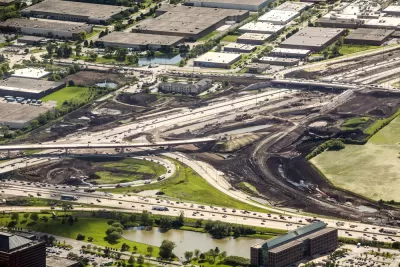When the public learns that freeway pollution discriminates against nearby residents with devastating health consequences, the tide of public opinion will finally turn against the automobile—a call to action by Bill Adams.

(Updated 02/04/2016) UFP (ultrafine particulate) air pollution effects people living, working, or going to school near freeways, with devastating consequences. However, there is little public understanding of the difference between UFP and ozone pollution, i.e., smog, writes UrbDeZine editor Bill Adams. In a prior article, he detailed the scientific findings about UFP pollution, including:
- Heart disease, lung function impairment, leukemia, asthma, and lung cancer, are some of the conditions that have been associated with UFP exposure
- The UFP high danger zone is the area roughly within 1,000 - 1,500 feet of either side of a high-traffic roadway, with variations due to topography, wind direction, and other factors.
- UFP substantially stunts lung development in children living within 500 meters of busy roadways compared to those living more than 1,500 meters away.
- 6 million school children are exposed to dangerous levels of UFP because of the location of their schools.
- Low income and minority communities are disproportionately impacted by UFPs.
However, as evidence accumulates, public understanding will grow, predicts Adams:
"When people view highways as rivers of toxic air importing disease and death into nearby neighborhoods, rather than as simply regional polluters, resistance to road projects and demand for protection from existing highways will dramatically increase. The cost of road projects and mitigation, including mitigation of emissions from existing highways, will dramatically increase, making transit projects more cost effective."
The effect on property values and profits within these highway pollution zones may be an even greater agent of change, writes Adams. He goes on to urge readers to get the word out to save lives and improve the built environment.
[The headline of this post was updated to reflect the correct usage of scientific terms.]
FULL STORY: Could this little-known pollutant finally change our transportation priorities?

Maui's Vacation Rental Debate Turns Ugly
Verbal attacks, misinformation campaigns and fistfights plague a high-stakes debate to convert thousands of vacation rentals into long-term housing.

Planetizen Federal Action Tracker
A weekly monitor of how Trump’s orders and actions are impacting planners and planning in America.

San Francisco Suspends Traffic Calming Amidst Record Deaths
Citing “a challenging fiscal landscape,” the city will cease the program on the heels of 42 traffic deaths, including 24 pedestrians.

Defunct Pittsburgh Power Plant to Become Residential Tower
A decommissioned steam heat plant will be redeveloped into almost 100 affordable housing units.

Trump Prompts Restructuring of Transportation Research Board in “Unprecedented Overreach”
The TRB has eliminated more than half of its committees including those focused on climate, equity, and cities.

Amtrak Rolls Out New Orleans to Alabama “Mardi Gras” Train
The new service will operate morning and evening departures between Mobile and New Orleans.
Urban Design for Planners 1: Software Tools
This six-course series explores essential urban design concepts using open source software and equips planners with the tools they need to participate fully in the urban design process.
Planning for Universal Design
Learn the tools for implementing Universal Design in planning regulations.
Heyer Gruel & Associates PA
JM Goldson LLC
Custer County Colorado
City of Camden Redevelopment Agency
City of Astoria
Transportation Research & Education Center (TREC) at Portland State University
Jefferson Parish Government
Camden Redevelopment Agency
City of Claremont



























